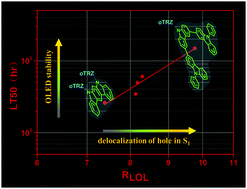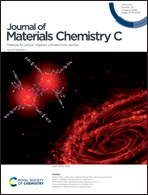Expanding the hole delocalization range in excited molecules for stable organic light-emitting diodes employing thermally activated delayed fluorescence†
Abstract
Metal-free, thermally activated delayed fluorescent (TADF) emitters have emerged as a promising new generation of organic light-emitting diode (OLED) materials. Donor–acceptor (D–A) structures are widely used in TADF molecular design to ensure a small energy splitting between the singlet and triplet excitons. Here, a series of efficient bluish-green TADF emitters are constructed using one or two phenyltriazine acceptors and one tercarbazole, bicarbazole or indolo[2,3-b]carbazole donor through an ortho-linkage. The impact of the D/A ratio on the photoluminescence and electroluminescence stability of these emitters in doped films is thoroughly investigated. According to the two-exciton dynamics and the degradation products, device degradation is deduced to be a result of electrophilic substitution between two charge-transfer excitons. Within a limited molecular weight range, increasing the number of acceptor moieties leads to a decrease in the hole delocalization range in the excited state, which facilitates the substitution reaction. Based on an optimized device structure, the device containing an emitter with bulk a tercarbazole donor achieves a long half-life of 1512 hours with an initial luminescence of 1000 cd m−2. Our findings reveal a possible mechanism for exciton–exciton and exciton-polaron annihilation-induced device degradation and provide new approaches for achieving stable OLEDs employing TADF.



 Please wait while we load your content...
Please wait while we load your content...